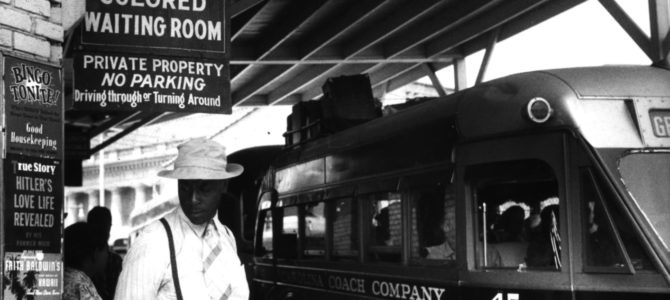
What happened to the dream of a post-racial America? From fights over confederate statues, to the Black Lives Matter movement, to the rise of the racist alt-right, to Donald Trump’s flirtations with racists, to the chumminess of many Democrats and left-wing activists with Louis Farrakhan, the vision of harmony seems to have vanished in a cloud of racially charged acrimony.
The Left tends to blame this on persistent structural racism and a backlash against the Obama presidency. The Right prefers to blame identity politics and political correctness for stoking division and anger. Both have some truth, and both are prone to overreach, but the problem may run deeper than either of these perspectives acknowledges. Can diversity, equality, and justice coexist with each other, especially in a nation where racial identities were created by slavery and segregation?
Anders Walker’s new book from Yale University Press, The Burning House: Jim Crow and the Making of Modern America, offers a provocative scholarly take on the problems of racial identity, diversity, and justice. Walker, a law professor at Saint Louis University, argues that the current emphasis on diversity is in large part derived from pluralist views that developed in the Jim Crow South. Deftly deploying extensive quotations, Walker explores these ideas as they were expressed by writers such as William Faulkner, James Baldwin, Flannery O’ Connor, and Supreme Court Justices Lewis Powell and Clarence Thomas. He claims they have shaped culture and jurisprudence regarding diversity in important but unappreciated ways.
These figures, white and black, recognized that slavery and Jim Crow had forged a distinct black culture and identity, which raised the question of whether racial integration would mean losing that cultural heritage. Was African-American culture worth preserving, at least in part? If so, could blacks improve their status and demand justice without losing their culture and identity in integration? How much did they even want to integrate their lives with those who were still legally oppressing them?
Omnipresent Violence
Some Southern whites raised pluralist points on behalf of segregation, claiming that the region’s divided culture actually reduced racial tensions and protected blacks by providing them their own sphere of life. They declared that Northern reformers should attend to their own problems, rather than trying to impose their cultural norms upon the South, and insisted that personal kindness and charity mitigated the harshness of legal segregation.
However, at best, the paternalistic gentlemen of the white South, such as Atticus Finch in Harper Lee’s classic To Kill a Mockingbird, were only sporadically able to restrain the savagery of the more virulent racists around them. Their claims to soften segregation were vitiated by their inability or unwillingness to effectively restrain and punish the depredations and injustices regularly committed against freed slaves and their descendants.
Try to ignore it as they might, the Jim Crow system required brutality, demanding “a level of deference from blacks that could not have been maintained without the omnipresent threat of violence.” The cultural pluralism of the South was not a free, organic development, but the result of repression. White Southern agrarians had fine words and ideas about localism, pluralism, and cultural diversity, but used them to try to perfume the stinking corpse of slavery that was segregation.
Meanwhile, while they loathed the oppression of segregation, there were nonetheless blacks who sounded some similar notes regarding assimilation into the dominant white culture. They wanted the boot (or, more accurately, the noose) of violent oppression off their necks, but they were reluctant to completely abandon the unique black identity and culture that developed in response to slavery and segregation.
For example, Walker notes that James Baldwin seemed conflicted in an interview he gave to Robert Warren (a writer examined in The Burning House). On one hand, “Baldwin seemed to argue for integration, or a world in which race ‘would count for nothing.’ On the other, he made a strong case for preserving a distinctly black perspective on America, its history, and its shortcomings.” Men and women like Baldwin were proud of African-American resilience and achievement, and resented the extent to which many ostensible white allies, including the Supreme Court in Brown v. Board of Education, portrayed black culture as pathological.
At the extremes this suspicion of assimilation led to black separatism, nationalism, hatred, and violence. But it need not, and the problem of reconciling inclusion into the opportunities of mainstream white America, without abandoning black culture and identity was (and is) persistent.
We are social and mimetic beings whose identities form in response to those around us. Cultural identities developed over generations are persistent, and the end of legal segregation could not create a racial year zero. America had created distinct racial cultures living side by side, and the identities they produced were at least as strong as those based on factors such as class and religion. Was this diversity, or aspects of it, worth preserving and promoting? Some thought so, even if they opposed the legal repression that had created it.
Diverse Views on ‘Diversity’
After exploring these themes, Walker argues that ideas of pluralism and diversity that originated with white Southern agrarians entered into law via Supreme Court Justice Powell, who saw diversity as “a bulwark against big government, a preservative of local particularity, and a guarantor of cultural innovation and growth.” This led Powell to repeatedly invoke “pluralism as a rationale for tolerating lingering inequality.”
Legal segregation had ended, and he believed that government should not exceed its constitutional limits (as he saw them) in attempting to rectify and recompense all of its wrongs. Heavy-handed attempts to ensure equality would likely fail, and the uniformity they sought would destroy the pluralism of American in the process.
This understanding of pluralism was, Walker claims, the basis for Powell’s ruling in the Bakke decision that it was unconstitutional to use racially discriminatory quota systems to try to compensate for past racial discrimination, but permissible for race to be considered as a factor for purposes of diversity in education. Government had to be limited in attempts to produce equality, but schools might reasonably desire a diverse student body as part of their educational mission, and therefore legitimately seek to include students of different backgrounds, income levels, races, and so on. This pluralist justification for taking race into account has been seized upon, and often mutated, by those wishing to use racial preferences to remedy racial injustice.
In contrast, Justice Clarence Thomas has been critical of Powell’s approach and its progeny. Walker explains that this is because Thomas believes that black students selected for diversity rather than grades will “find themselves behind academically yet also on display so that white students and white institutions could feel better about themselves.”
In contrast to this “diversity” that treats minority students as education enhancers for white students, Thomas has been a defender of institutional diversity, including historically black colleges. Pluralism, in his view, is more than a variety of skin tones at every school. Rather, it requires that single-sex colleges, historically black colleges, religious schools, etc. should all be free to fulfill what they see as their distinct missions.
Although this book might have benefited from more jurisprudential analysis, it is nonetheless a valuable contribution to our understanding of diversity, identity, and jurisprudence. For instance, the complications of identity and diversity Walker identifies may be seen in the difficulties of higher education, where diversity has been embraced as indispensable, but is beset by contradictions in practice.
The rationale given for diversity in education is that it provides an enriching variety of perspectives and experiences. However, this is usually applied only to select traits, such as racial, sexual, and gender identities, while neglecting others, such as political diversity. Indeed, this approach to diversity celebrates punishing nonconformist groups and institutions that are seen as exclusionary, such as Christian student groups that require conformity to traditional Christian standards of sexual behavior.
For all of their talk of multiculturalism and diversity, our elites, including education leaders, tend to have a poor understanding of perspectives other than their own. The result is a tendency toward a multihued monoculture, which is illustrated by the drearily similar ads for most universities. This shallow diversity is perhaps why those who take identity seriously have lately tended toward identity politics that flirt with racial essentialism, as seen in attempts to treat art, culture, and philosophy as if they were racial property.
Resolving the Contradictions
To conservative critics, such diversity appears partisan and power-hungry rather than pluralist, encouraging a superficial diversity of appearance and sexual appetites while enforcing intellectual conformity. Unfortunately, while there is merit to this critique, conservatives have struggled to provide an alternative narrative that recognizes the history and intricacies of race and identity in America.
There is a tendency to be ahistorical about racial identity, or to indulge white resentment, both of which can be seen in the automatic complaints some on the Right make about any acknowledgement of black identity or culture. Criticism of the inanities and excesses of identity politics (especially on campuses) is not enough. A successful conservative account of pluralism will need to be historically conscious and cognizant of the variety of forms diversity can take.
Can the complexities, contradictions, and resentments of American racial identity be resolved, or at least ameliorated? Walker suggests at least one possibility, writing that “[Ralph] Ellison recommended a change in the ‘basis of society’ that would incorporate black culture into American identity and highlight it. ‘In Negro culture,’ he concluded, ‘there is much of value for America as a whole.’”
Rather than being abandoned during integration, black identity and heritage would become part of the larger American identity and narrative. Imperfectly, this has happened, aided by an increasingly multiracial society. For all the sturm und drang about race, tens of millions of Americans are living as friends and family with those of another race.
Rev. Martin Luther King Jr. often presented the civil rights movement as seeking the fulfillment of America’s promise. His inclusion in the pantheon of American heroes is an acknowledgment that he was right. The African-American cultural heritage is inescapably part of Western, and specifically American, culture. To abandon it would be to abandon part of the American heritage.
Finally, beyond the scope of Walker’s book, and outside the realm of courts, legislatures, and other government efforts and institutions, men and women of every color can find a common identity as children of God. But despite the indispensable contributions of clergy and congregations to the civil rights movement, this promise is too little fulfilled in American churches. Recently, The New York Times reported that some black congregants are leaving majority-white evangelical churches, potentially reversing evangelical efforts toward racial reconciliation and integration.
For Christians, the divisions of the church are a reminder of the legacy of sin and our need for forgiveness. It is only grace that makes us whole. The vision of heaven in which members of every tribe, tongue and nation unite around God’s throne does not abolish pluralism, but provides a unity within it, confirming our identity as children of God and dear brothers and sisters in Christ Jesus.









